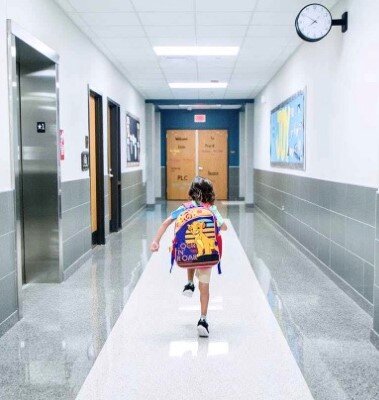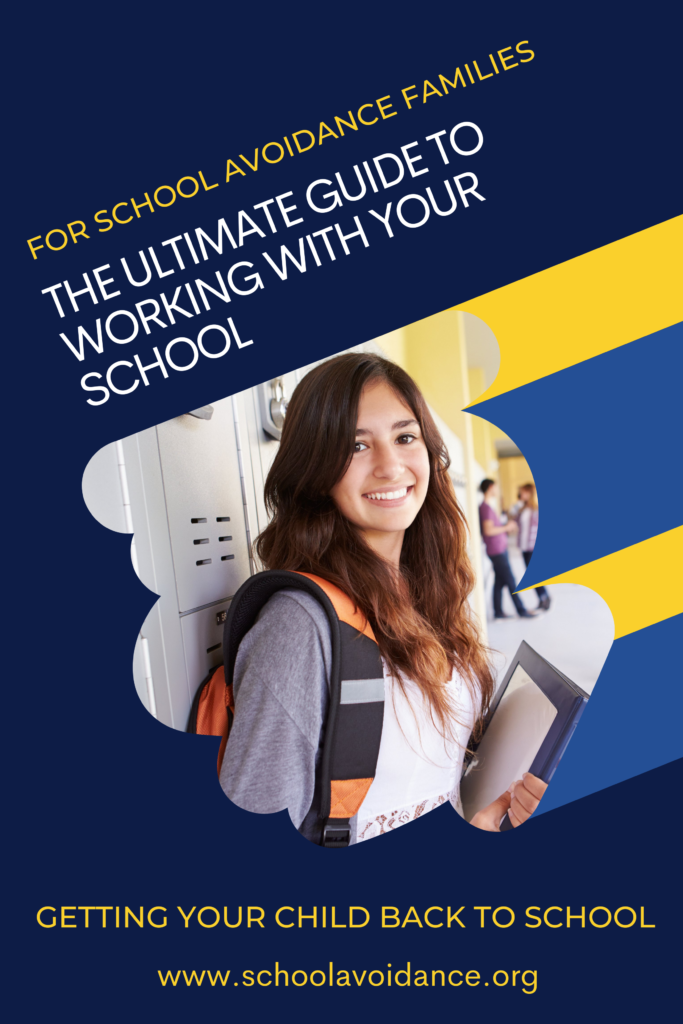
When I was in the thick of things with my son’s school refusal, I wish I could have spoken to other parents dealing with the same problem; discuss what was working, what failed, and just the support from another human living a similar experience would have provided comfort.
School refusal is complicated. There is no universal protocol and there is limited research to guide us. Therefore, an interchange of ideas and information is key to helping our kids.
With this in mind, I am happy to share information from a school refusal parent in the UK who has a helpful blog. Her article stood out because she makes important points not often mentioned when discussing this topic.
I added italicized comments in the “Do’s and Don’ts” section because I feel it’s helpful to see our viewpoints together.
The Do’s and Don’ts of Supporting a Child with School-Based anxiety (aka School Refusal)
By The Learning Curve PDA (Pathological Demand Avoidance, Autism)
Firstly I have deliberately framed ‘school refusal’ in this way because it is often forgotten that this is what it is – anxiety (and even, at its worst, a phobia) at least in the vast majority of cases. When you frame it in this way you can see how ridiculous the way it is often dealt with by punishment or reward, threatening parents with prosecution or encouraging parents to forcibly drag children into school. If a child is afraid, even terrified how is any of this going to help? Much more likely it will make things even worse.
The best way I can explain it is by explaining my phobia of deep water. You see as a child I was anyways worried around deep water and at the primary time was taken to improve my confidence and I was allowed to swim with my head up out of the water. When I went on to secondary my teacher was discussed at how far I’d been allowed to fall behind in my swimming. For some reason, she thought it would be a good idea for me to jump off the diving board into 20 ft of water to improve my swimming! She then proceeded to offer me a pole to hang on to and as I reached for it she moved it. The whole experience was traumatic. It left me with a phobia and huge suspicion of my swimming teacher, I did all I could to get out of swimming after that,
As I got older I have learned I am ok with deep water as long as I know where the shallower part or edge is, I have improved my confidence. School refusal often ends up with the equivalent of throwing a child into that diving pool day after day and expecting their fears to lessen when instead they know what’s coming and the fight and flight increases, trust and mental health is damaged. Changing the environment to a more safe and friendly one and building trust and starting small is like reassuring that phobic child it will be more of a paddling pool this time and proving it, so in the process building confidence and trust with supporting adults. All too often the ‘metaphorical‘ pool never changes and neither do the relationships around it, the emphasis for change remains firmly with the child.
My own son’s school refusal (or should I say school-based anxiety) became so bad he was put into an intervention service at 9 and eventually was unable to engage in formal education so I now home-educate him. I have at one time or another tried pretty much everything and so I can see the things that went wrong, the things that worked a bit for a while or may have worked if I had understood sooner. I certainly understand what does not work and only makes things much worse! So here are my dos and don’ts for parents struggling to support their children through school refusal.
Don’ts
Don’t be fobbed off (brushed off, deterred) when you raise concerns about school anxiety
Agree
Don’t forcibly drag your child to school.
Agree, these are the worst memories for me, if a therapist/school staff wants you to do this, listen to your gut!
Don’t offer rewards and consequences.
Agree, this may cause disagreement because many therapists recommend this technique. It did nothing for us with my 13-year-old son. Maybe it’s helpful for younger kids.
Don’t feel pressured by the school and pass that pressure on to your child.
Agree, obviously you want your child back in school too, you are trying to get them back, but the constant pressure of another party pushing for this end goal, can create anger, stress, and frustration for you, that can make you do things like yell at your child, drag your child and be in a constant state of misery which helps no one!
Don’t expect things to change unless the causes of the anxiety are dealt with.
This is tricky, yes we need to get to the heart of the matter, address anxiety-provoking situations/things, but this can take a great deal of time, especially with kids who often cannot articulate the causes. A child can get back to school while still anxious with proper support and guidance. My son was able to get back to school while the exact causes of his anxiety were not pinned down. Yes, we knew he had social and general anxiety disorder but he was still a work in progress
Don’t accept that your child is ‘fine’ in school if you feel they are not.
Agree, mom’s gut is always right.
Don’t be afraid to go over the person’s head you are currently dealing with.
Agree, your child is most important, not who you may offend, and not the hierarchy of the school’s personnel. For example, I wasted almost a year asking our guidance counselor for a 504 plan, she never told me that she cannot make this happen and that I should be requesting this directly to the school’s Child Study Team.
Do’s
Do talk to the school at the first sign of this happening
Agree
Do ask yourself, the school and your child what might be triggering this.
Agree
Do keep the preparation for school and journey to school as calm as possible.
Agree
Do have a daily communication diary between you and the school to record what is happening.
Agree, it is helpful to keep track of what is being done to help you and what is not. This can all get confusing and details can become fuzzy as time passes. In the U.S. if you need to bring in attorney, this is important for your case, the school may argue that you are wrong or mistaken. So protect yourself.
Do take your child to a GP and ask them to sign your child off with anxiety if needed.
This step is probably important for UK families who have different laws and procedures with special education. For U.S. families I believe that you should go directly to a psychiatrist or psychologist since General Practitioners aren’t trained in mental illness or school refusal. But you can always call their office for a referral to a mental health professional. It is possible that the school is getting on your case for unexcused absences and that your GP can get you a note for the attendance office the quickest
Do keep in regular contact with the school (daily if necessary) about any problems.
Agree, if this is regarding changes, improvements, problems at home or school. Not sure about daily though.
Do email referring to conversations and clarify what’s been said so you have a written record.
Agree, email keeps a nice record of the exchanges. When talking by phone, keep a note of the day, time, who was on the call and the important points.
Do ask the school what they are doing to make the classroom less anxiety-inducing.
Agree, if this is important to your child. In the U.S. these supports and accommodations should come under a 504 plan or IEP. But these do take some time to institute, so you should ask for these changes as soon as you can and not wait for the official documents.
Do ensure your child is allowed to create strong trusting relationships with adults at school.
Agree, having kind, empathetic teachers who will proactively try to engage your child can be very helpful.
Do consider trying different morning routines when arriving at school.
Agree, always look for better or other options if something isn’t working
Do check sensory triggers around uniform and in the classroom.
Agree if your child has these sensory issues. Not all children do. Mine did not.
Do give a space safe for your child to talk about any issues at school.
Agree, your child should have an agreed-upon person and location in school to feel safe and seek help if needed.
Do think outside of the box and look for alternative solutions.
Agree, never give up hope and determination to find any solutions for your child.
Do acknowledge that you know how hard it is for them to go into school.
Agree, love and understanding always.
Some strategy suggestions for school
First and foremost address any unmet SEND (This is similar to the Individuals with Disabilities Act (IDEA) in the U.S. SEND stands for Special Education Needs and Disability Regulation) and have the paperwork and training in place to back that up. Ensure any known SEND with an EHCP (This is similar to our Individualized Education Plan (IEP) in the U.S). is appropriate and being followed by all staff correctly.
Use already existing trusted relationships to give the child confidence whether that be a peer, a TA, a particular teacher, counselor or whoever.
Buddy the child up ideally with a trusted friend.
Have a buddy and or trusted member of staff come out and meet the child outside the school building and give them a chance to relax before entering.
Rule out the possibility of bullying being the trigger in pupils and staff.
Rejig the seating plan so the child can feel safe and comfortable both in terms of the people around them and their environment. Involve the child and or parent or TA
Use the child’s interests to build trusting relationships with other adults.
Use a trusted adult to introduce new potential trusted adults.
Give the child an escape route. A table near the door and a timeout card for example.
Make sure all adults dealing with the child are on the same page and up to date with the child’s plan/EHCP.
Try giving the child a position of power/responsibility. Some times being the one in charge of the register or the one who listens to the younger children read for example can build confidence and a sense of belonging.
Be led by the child. Do not try and force the child to do more as soon as they can do one thing. For example, if they are managing an hour in school don’t try and push it to two rather try and engage them so much they want to stay longer and let them quit while they are ahead. This will build confidence and enthusiasm for returning the next day.
Don’t make a big thing of it if a child returns to school after a break and discourage children in the class from doing so. It can be overwhelming so friendly but understated welcome may be better.
Relax uniform policy for the child if they have sensory issues.
Don’t draw attention to a child who comes in late, this can be off-putting for them and they have made it in after all.
I guess really what I am saying to parents and school staff is that the anxiety is just the symptom. Whether it be unmet SEND, lack of trusting relationships, the school environment triggering sensory issues, all areas need to be looked at and changed accordingly. If nothing much changes in the about the school experience nothing much will change (at least for the positive) about the child’s anxiety around going in, you need to look at the whole picture.
Shared Courtesy of THELEARNINGCURVEPDA






